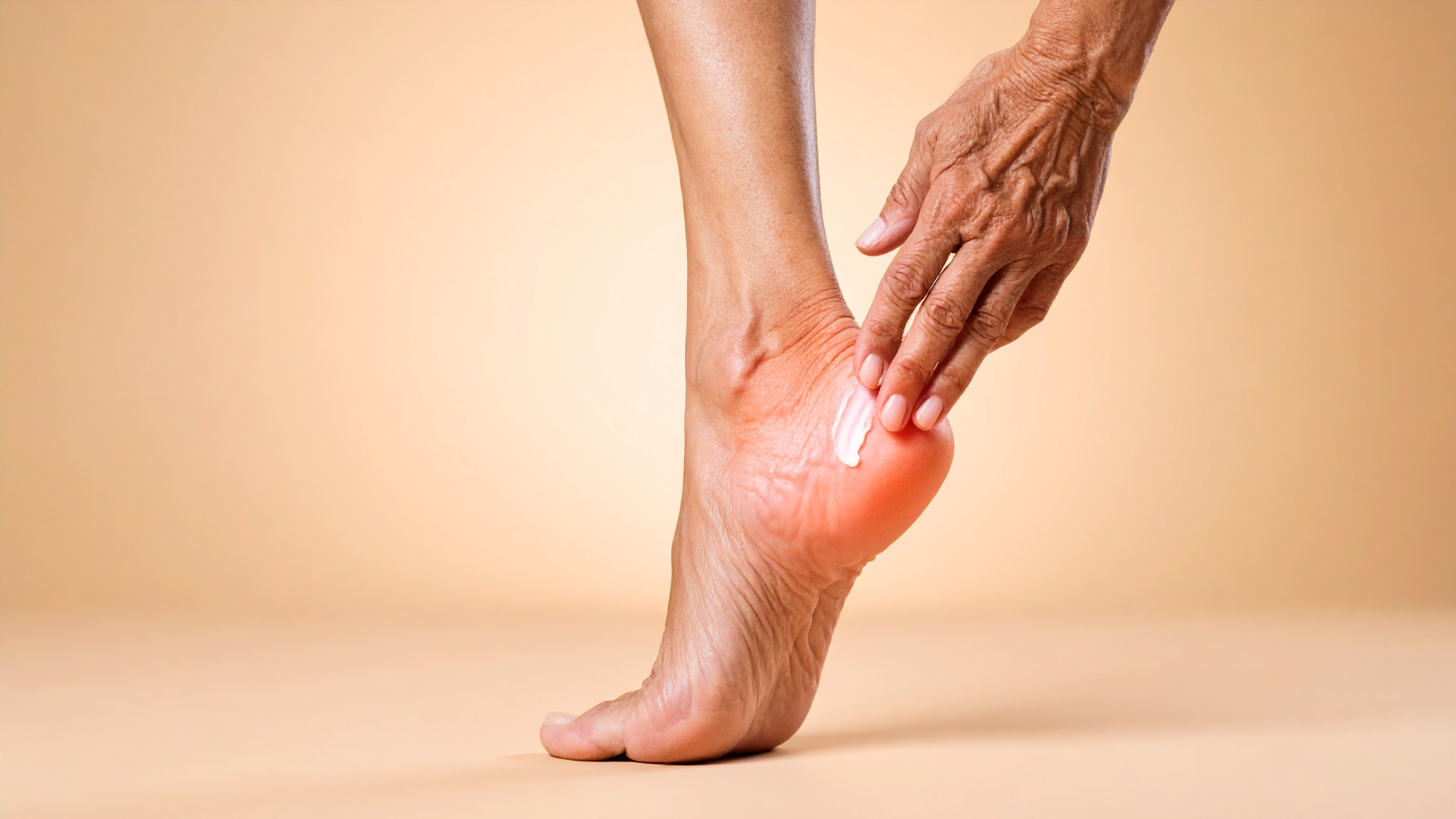Let's be honest – nerve pain is brutal. Whether it's that constant burning in your feet, the shooting pain down your leg, or those maddening tingles that keep you up at night, neuropathy doesn't just hurt your body; it messes with your life.
I remember talking to Sarah, a 52-year-old accountant, who described her diabetic neuropathy like this: "It feels like someone's holding a blowtorch to the bottom of my feet while simultaneously stabbing them with tiny needles. And it never stops." If you're dealing with nerve pain, you probably know exactly what she means.
You've probably tried the usual suspects: prescription pills that make you drowsy, over-the-counter meds that barely touch the pain, or maybe even some questionable "miracle cures" you found online at 2 AM during another sleepless night. Here's the thing – there's actually a solution that many people overlook, and it might be exactly what you need.
Enter nerve cream – the unsung hero of neuropathy relief.
Why Nerve Creams Are Different (In the Best Way)
Picture this: instead of swallowing a pill that affects your entire body just to treat pain in your feet, what if you could apply relief directly where it hurts? That's exactly what neuropathic cream does.
Think about it – when you have a headache, you might take aspirin. But when you have a cut, you put a bandage on it, not inside your stomach. Nerve creams for nerve pain work on this same logical principle: treat the problem where it lives.
Most oral medications for nerve pain work by affecting neurotransmitters throughout your entire nervous system. That's why gabapentin can make you feel groggy, or why pregabalin might mess with your coordination. These medications are like using a sledgehammer when you really need a precision screwdriver.
Here's why topical treatment matters more than you might think:
Faster relief: The active ingredients go straight to your problem areas instead of taking a scenic tour through your digestive system. While oral medications can take 30-60 minutes to kick in (and that's if your stomach cooperates), topical treatments start working within minutes.
Fewer side effects: No more worrying about drowsiness, stomach upset, or that "medicated" feeling that comes with oral medications. Your liver doesn't have to process anything, and your brain stays clear.
Targeted action: Got burning feet? Apply it to your feet. Tingling hands? Hands get the treatment. Neck pain from nerve compression? You get the idea. It's precision medicine at its simplest.
Lower systemic absorption: Unlike pills that flood your bloodstream, most topical treatments have minimal systemic absorption, meaning the medication stays where you put it.
Stackable with other treatments: You can often use nerve creams alongside your existing medications without worry about drug interactions (though always check with your doctor first).
Understanding Your Nerve Pain: The Foundation for Better Treatment
Before diving into which cream might work best for you, it helps to understand what's actually happening in your body. Nerve pain, or neuropathy, occurs when your peripheral nerves – the ones outside your brain and spinal cord – become damaged or dysfunctional.
These nerves are like electrical wires carrying messages between your brain and the rest of your body. When they're damaged, they can send false alarm signals, creating pain where there shouldn't be any. It's like having faulty smoke detectors that go off when you're just making toast.
Common causes include:
-
Diabetes: High blood sugar damages nerve fibers over time
-
Chemotherapy: Cancer treatments can be toxic to nerves
-
Autoimmune conditions: Your immune system attacks your own nerves
-
Physical injury: Trauma that damages nerve pathways
-
Vitamin deficiencies: Particularly B12, which is crucial for nerve health
-
Infections: Like shingles, which can leave lasting nerve damage
The pain itself can manifest as burning, shooting, stabbing, tingling, numbness, or hypersensitivity to touch. Many people describe it as wearing socks made of sandpaper or walking on broken glass.

The Science Behind the Relief (Without the PhD Required)
Your nerves are basically your body's electrical system, and when they malfunction, they send pain signals even when there's no real danger. It's like having a car alarm that won't stop going off. Nerve cream works by either calming these overexcited nerves or interrupting their pain signals altogether.
The beauty of topical treatments lies in their ability to target specific types of nerve receptors and pain pathways right at the source. Different active ingredients work through different mechanisms, which is why some creams might work better for your specific type of pain than others.
Let me break down the main players in the nerve cream game:
Capsaicin: The Spicy Solution That Actually Works
Remember the last time you ate something really spicy? That heat you felt comes from capsaicin – and it turns out this compound is incredibly effective for nerve pain. There's actually over 30 years of research backing up capsaicin's effectiveness for neuropathic pain.
Here's the fascinating part: capsaicin initially makes things feel warmer (sometimes even a bit burny), but it's actually training your nerves to chill out. It works by binding to TRPV1 receptors, which are involved in detecting heat and pain. This binding causes a temporary increase in pain signals (that initial burning sensation), but with regular use, capsaicin effectively depletes Substance P – a neurotransmitter responsible for transmitting pain signals to your brain.
Think of Substance P as the messenger that carries pain signals. Capsaicin essentially exhausts these messengers, so they can't deliver their painful messages as effectively. It's like overworking the office gossip until they're too tired to spread rumors.
What to expect: The first few applications might feel warm or tingly. Don't panic – this usually fades within 10-15 minutes and gets less noticeable over time. Some people experience what researchers call the "initial flare" – a temporary increase in symptoms during the first few days of use. Push through it if you can; the benefits typically kick in after consistent use for about a week.
Best for: Diabetic neuropathy (especially cream for feet neuropathy), postherpetic neuralgia (shingles pain), arthritis-related nerve pain, and chronic burning sensations. Studies show it's particularly effective for diabetic foot pain, with some research indicating up to 40% pain reduction in regular users.
Pro tip: Start with a lower concentration (0.025%) before moving up to stronger formulations (0.075% or higher).
Menthol: The Cooling Agent
If capsaicin is the fire, menthol is the ice. This ingredient creates an immediate cooling sensation that essentially tricks your nervous system into paying attention to the cool feeling instead of the pain. It's based on something called the "gate control theory" of pain – the idea that non-painful sensations can override pain signals.
Menthol works by activating TRPM8 receptors, which detect cold. When you apply a menthol-based cream, these cold receptors fire rapidly, creating signals that travel faster along nerve pathways than pain signals. Your spinal cord can only process so much information at once, so the cooling sensation effectively "crowds out" the pain signals.
What to expect: Instant cooling relief with a gentle tingling sensation. The effect usually lasts 2-4 hours, depending on the concentration and your individual sensitivity. Many people find this particularly soothing for burning feet or that "pins and needles" feeling that makes you want to shake your hands or feet.
Best for: Fibromyalgia, sciatica, restless leg syndrome, and that restless, burning sensation that keeps you awake. It's also excellent for acute flare-ups when you need immediate relief.
Bonus benefit: The cooling sensation can be psychologically soothing as well, providing a sense of relief that goes beyond just the physical mechanism.
Lidocaine: The Quick Fix
Lidocaine is like putting a temporary mute button on your nerves. It's a local anesthetic that blocks voltage-gated sodium channels, preventing nerve impulses from forming or traveling. Essentially, it stops the electrical signals that create pain sensations.
This is the same stuff dentists use to numb your mouth, just in a much lower concentration and designed for skin application. It's particularly effective because it doesn't just mask pain – it actually prevents the nerve from firing pain signals in the first place.
What to expect: Noticeable numbing within 10-20 minutes that can last several hours. The skin might feel slightly thick or less sensitive to touch. It's not a long-term solution, but it's fantastic for acute flare-ups or when you need to function normally for a few hours.
Best for: Shingles-related nerve pain (postherpetic neuralgia), sudden nerve pain episodes, localized nerve injuries, and when you need relief right now. It's also helpful before physical therapy or activities that might normally trigger pain.
Important note: Over-the-counter lidocaine creams typically contain 4-5% lidocaine, while prescription versions can go up to 20% for more severe pain.
Natural Herbal Blends: The Gentle Giants
For those who prefer a softer approach or have sensitive skin, herbal nerve creams combine time-tested botanical ingredients. While they might not have the immediate dramatic effect of pharmaceutical options, they offer gentle, supportive relief with excellent safety profiles.
Key ingredients often include:
Arnica: This mountain flower has been used for centuries for pain and inflammation. While the mechanism isn't fully understood, studies suggest it may reduce inflammatory compounds and improve circulation.
Turmeric (Curcumin): A powerful anti-inflammatory that may help reduce the chronic inflammation often associated with nerve damage. Some studies suggest it might also help protect nerves from further damage.
Comfrey: Traditionally used for healing, it contains allantoin, which may help repair damaged tissue and reduce inflammation.
Essential oils: Lavender, peppermint, and eucalyptus can provide aromatherapy benefits while offering mild analgesic effects.
What to expect: Mild, soothing sensations with no dramatic warming or cooling. Think of it as a supportive friend rather than a dramatic intervention. You might notice a gradual improvement in comfort over weeks rather than immediate relief.
Best for: Sensitive skin, mild to moderate nerve pain, daily maintenance care, and as a complement to other treatments.
Real Talk: What Actually Happens When You Use These Creams
Let me paint you a realistic picture because I believe in setting proper expectations. The first time you use a neuropathic cream, you might be surprised by what you feel:
-
Capsaicin creams: "Whoa, that's warm!" followed by "Is this supposed to feel like mild salsa on my skin?" (Don't worry, it fades, and that warmth often becomes quite pleasant)
-
Menthol creams: "Ahh, that's refreshingly cool" followed by "I feel like I rubbed mint toothpaste on my leg, but in a good way"
-
Lidocaine creams: "I can barely feel my skin there" followed by "This is weird but wonderful – I forgot this area could feel normal"
-
Natural creams: "This is... nice and gentle" followed by "I'm not sure if it's working, but my skin feels happy"
Here's the important part that many people don't realize: most nerve creams aren't instant miracle workers (except lidocaine for temporary relief). They're more like training your nerves to behave better over time. Consistency is key – think of it as physical therapy for your pain receptors.
Many people give up too early because they expect immediate, dramatic results. The reality is that nerve healing and pain reduction often happens gradually. Capsaicin, in particular, often gets worse before it gets better, which can be discouraging if you don't know to expect it.
Finding Your Perfect Match: A Real-World Guide
Choosing the right nerve cream isn't rocket science, but it does require some honest self-reflection about your pain, lifestyle, and preferences. Here's a more detailed breakdown:
If you have diabetic neuropathy or persistent burning feet: Start with capsaicin, but be patient. Research specifically on diabetic neuropathy shows capsaicin can reduce pain intensity by 30-50% with regular use. The key is consistent application – twice daily for at least 2-4 weeks to see maximum benefit.
If you can't stand any warming sensations or have very sensitive skin: Go with menthol or natural blends. Some people find even mild heat intolerable, especially if their skin is already hypersensitive from nerve damage.
If you need immediate relief for flare-ups or specific activities: Lidocaine is your friend. Keep a tube handy for those moments when pain spikes unexpectedly or before activities that typically trigger symptoms.
If you have widespread pain or fibromyalgia: Consider menthol-based formulas with additional anti-inflammatory ingredients. The cooling sensation can be particularly soothing for the widespread burning that fibromyalgia often causes.
If you prefer natural approaches or are concerned about chemical sensitivities: Natural herbal blends are ideal, but give them more time to work – think months rather than weeks for full benefits.
If you're not sure what type of pain you have: Start with a menthol-based cream – it's usually well-tolerated, provides noticeable relief, and can help you gauge how your skin responds to topical treatments.
The Smart Way to Use Nerve Creams: Expert Tips
Here's what I wish someone had told me when I first started researching these treatments (and what healthcare providers often forget to mention):
1. Start small and test first: Apply a small amount to an inconspicuous area and wait 24 hours. Your skin might be more sensitive than you think, especially if nerve damage has affected your ability to sense irritation normally.
2. Timing matters: For capsaicin, many people find evening application works best because you can deal with the initial warming sensation while watching TV rather than trying to work. For menthol, it can be energizing, so morning might be better.
3. Wash your hands immediately: Especially with capsaicin – trust me on this one. You don't want to accidentally touch your eyes, mouth, or other sensitive areas. Use dish soap rather than regular hand soap for capsaicin; it cuts through the oils better.
4. Don't go overboard: More isn't always better. A thin layer is usually sufficient, and over-application can lead to skin irritation without increased benefit.
5. Give it time: Most creams need consistent use to show their full potential. Mark your calendar and commit to at least 2 weeks of regular use before deciding if something works.
6. Keep notes: Track what works and what doesn't, including time of day, how much you used, and your pain levels before and after. Your future self will appreciate it, and it's valuable information to share with your healthcare provider.
7. Layer smartly: If you're using multiple treatments, apply them in the right order – thinnest consistency first, thickest last. Wait a few minutes between applications.
8. Weather and skin condition matter: Dry skin absorbs products differently than well-moisturized skin. Hot weather can intensify the effects of capsaicin, while cold weather might make menthol feel more intense.
Maximizing Your Results: The Complete Strategy
Using nerve cream effectively isn't just about slapping it on and hoping for the best. Here are some strategies to get the most out of your treatment:
Create a routine: Consistency beats intensity every time. It's better to apply a moderate amount twice daily religiously than to apply a lot sporadically.
Combine with other therapies: Nerve creams work well alongside gentle massage, warm (not hot) baths, light stretching, or even meditation. The key is creating a comprehensive comfort routine.
Address underlying factors: If poor circulation contributes to your nerve pain, gentle exercise might enhance the effects of topical treatments. If inflammation is a factor, consider dietary changes alongside your cream routine.
Monitor and adjust: Pay attention to what enhances or diminishes the cream's effectiveness. Some people find certain foods, stress levels, or activities affect how well their treatments work.
Your Next Step Forward
Living with nerve pain doesn't have to mean accepting a life of constant discomfort. Nerve creams offer a practical, targeted approach that can make a real difference in your daily comfort level without the systemic side effects of oral medications.
The beauty of topical treatments is that they're relatively low-risk ways to experiment with relief. You're not committing to a major medication change or invasive procedure – you're simply giving your nerves some targeted, external support.
Whether you're dealing with diabetic neuropathy in your feet, post-chemotherapy tingling, sciatica, or mysterious nerve pain that just won't quit, there's likely a neuropathic cream that can help. The key is finding the right match for your specific situation and giving it time to work.
Remember, managing chronic pain is often about progress, not perfection. You might not achieve complete pain freedom, but even a 30-40% reduction in symptoms can dramatically improve your quality of life. You might find you sleep better, have more energy for activities you enjoy, or simply worry less about your pain throughout the day.
Your comfort matters, and you deserve relief that doesn't compromise the rest of your health. Sometimes the best solutions are the simplest ones – and nerve cream might just be yours.
Start with one product, give it an honest trial of at least two weeks, and keep track of your results. Your journey to better nerve pain management begins with that first application.
Important note: While nerve creams are generally safe and effective, it's always wise to chat with your healthcare provider before starting any new treatment, especially if you have






